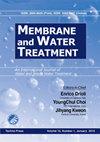Single- and multi-stage dairy wastewater treatment by vibratory membrane separation processes
IF 1.1
4区 工程技术
Q4 ENGINEERING, CHEMICAL
引用次数: 3
Abstract
Before discharge into sewage or living waters, dairy effluents need to be effectively treated to meet the requirements defined by environmental protection regulations. In addition to the commonly used technologies, membrane separation might offer a novel solution with many remarkable advantages. Although membrane fouling often limits its industrial scale application, module vibration can reduce membrane fouling. In this study, multi-stage membrane separations with ultrafiltration (UF), as pre-filtration, and nanofiltration (NF) were investigated. On the one hand, our aim was to separate the wastewater to reach the cleanest permeate possible, on the other hand to achieve the highest organic content in the smallest volume for further energetic utilization. Firstly, with one-stage separations the effects of Vibratory Shear Enhanced Processing (VSEP) on shear rate, fluxes and rejections were investigated. These tests revealed that vibration has a positive effect on fluxes and rejections. Secondly, two types of multi-stage UF/NF separation experiments were carried out and membrane fluxes, COD rejections and flux decreasing rates were examined. In type 1, permeates of nanofiltered UF permeates achieved the lowest organic load in purified wastewater to meet European environmental threshold limits for living waters. In type 2, concentrates of nanofiltered UF concentrates reached the highest possible volume reduction ratio (VRR) resulting in higher organic content in a smaller volume, which could increase the efficiency of biogas production as an alternative post-treatment for waste management.振动膜分离法处理单级和多级乳制品废水
在排放到污水或生活水中之前,乳制品废水需要进行有效处理,以满足环境保护法规规定的要求。除了常用的技术外,膜分离可能提供一种具有许多显著优点的新解决方案。尽管膜污染通常限制了其工业规模的应用,但模块振动可以减少膜污染。在本研究中,研究了超滤(UF)、预过滤和纳滤(NF)的多级膜分离。一方面,我们的目标是分离废水,以达到尽可能干净的渗透物,另一方面,以最小的体积达到最高的有机物含量,以进一步进行能源利用。首先,在一级分离的情况下,研究了振动剪切增强处理(VSEP)对剪切速率、通量和废品率的影响。这些试验表明,振动对通量和废品率有积极影响。其次,进行了两种类型的多级UF/NF分离实验,考察了膜通量、COD去除率和通量下降率。在类型1中,纳米过滤UF渗透物的渗透物在净化废水中实现了最低的有机负荷,以满足欧洲生活水的环境阈值限制。在类型2中,纳米过滤UF浓缩物的浓缩物达到了可能的最高体积还原率(VRR),从而在较小的体积中产生更高的有机物含量,这可以提高沼气生产的效率,作为废物管理的替代后处理。
本文章由计算机程序翻译,如有差异,请以英文原文为准。
求助全文
约1分钟内获得全文
求助全文
来源期刊

Membrane Water Treatment
ENGINEERING, CHEMICAL-WATER RESOURCES
CiteScore
1.90
自引率
30.00%
发文量
0
审稿时长
>12 weeks
期刊介绍:
The Membrane and Water Treatment(MWT), An International Journal, aims at opening an access to the valuable source of technical information and providing an excellent publication channel for the global community of researchers in Membrane and Water Treatment related area. Specific emphasis of the journal may include but not limited to; the engineering and scientific aspects of understanding the basic mechanisms and applying membranes for water and waste water treatment, such as transport phenomena, surface characteristics, fouling, scaling, desalination, membrane bioreactors, water reuse, and system optimization.
 求助内容:
求助内容: 应助结果提醒方式:
应助结果提醒方式:


